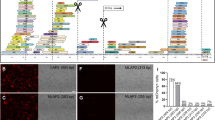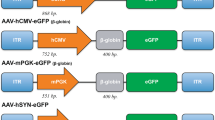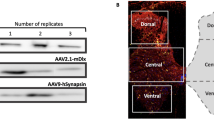Abstract
Using cell-type-specific promoters to restrict expression of therapeutic genes to particular cells is an attractive approach for gene therapy, but often hindered by inefficient transcriptional activities of the promoters. Knowing the enhancer for the human cytomegalovirus (CMV) immediate-early gene improves activities of several cell-type- or tissue-type-specific promoters, we set out to investigate whether it improves neuronal transgene expression driven by a neuron-specific promoter, the platelet-derived growth factor B-chain (PDGF-β) promoter. A hybrid promoter was constructed by appending a 380-bp fragment of the CMV enhancer 5′ to the PDGF-β promoter. The plasmid containing the promoter was complexed with polyethylenimine for in vitro and in vivo gene transfer. In cultured cells, the plasmid with the hybrid promoter significantly augmented expression of a luciferase reporter gene, providing expression levels 8- to 90-fold and 7- to 178-fold higher than those from two baseline constructs containing the PDGF-β promoter alone and the CMV enhancer alone, respectively. In particular, the activities of the hybrid promoter in two neural cell lines were close to or higher than that of the CMV immediate-early gene enhancer/promoter, a transcriptional control element that has been considered to be the most robust one identified thus far. After stereotaxic injection into the hippocampus and striatum in rats, the hybrid promoter displayed a neuronal specificity, driving gene expression almost exclusively in neurons. Transgene expression in the brain driven by the hybrid promoter was detectable 24 h after injection, being 10-fold higher than that driven by the PDGF-β promoter alone. The expression peaked around 5 days at 1.5 × 105 relative light units per brain and lasted for at least 4 weeks. This differed strikingly from the expression driven by the PDGF-β promoter, which was no longer detectable on day 3. The new gene regulatory construct reported in this study will be useful to improve neuronal transgene expression required for gene therapy of neurological disorders and functional studies of the nervous system.
This is a preview of subscription content, access via your institution
Access options
Subscribe to this journal
Receive 12 print issues and online access
$259.00 per year
only $21.58 per issue
Buy this article
- Purchase on Springer Link
- Instant access to full article PDF
Prices may be subject to local taxes which are calculated during checkout







Similar content being viewed by others
References
Miller N, Vile R . Targeted vectors for gene therapy. FASEB J 1995; 9: 190–199.
Miller N, Whelan J . Progress in transcriptionally targeted and regulatable vectors for genetic therapy. Hum Gene Ther 1997; 8: 803–815.
Nettelbeck DM, Jerome V, Muller R . A strategy for enhancing the transcriptional activity of weak cell type-specific promoters. Gene Therapy 1998; 5: 1656–1664.
Sasahara M et al. PDGF B-chain in neurons of the central nervous system, posterior pituitary, and in a transgenic model. Cell 1991; 64: 217–227.
Games D et al. Alzheimer-type neuropathology in transgenic mice over-expressing V717F beta-amyloid precursor protein. Nature 1995; 373: 523–527.
Georgopoulos S, McKee A, Kan HY, Zannis VI . Generation and characterization of two transgenic mouse lines expressing human ApoE2 in neurons and glial cells. Biochemistry 2002; 41: 9293–9301.
Peel AL et al. Efficient transduction of green fluorescent protein in spinal cord neurons using adeno-associated virus vectors containing cell type-specific promoters. Gene Therapy 1997; 4: 16–24.
Paterna JC et al. Influence of promoter and WHV post-transcriptional regulatory element on AAV-mediated transgene expression in the rat brain. Gene Therapy 2000; 7: 1304–1311.
Navarro V et al. Efficient gene transfer and long-term expression in neurons using a recombinant adenovirus with a neuron-specific promoter. Gene Therapy 1999; 6: 1884–1892.
Bartlett RJ et al. Long-term expression of fluorescent reporter gene via direct injection of plasmid vector into mouse skeletal muscle: comparison of human creatine kinase and CMV promoter expression levels in vivo. Cell Transplant 1996; 5: 411–419.
Paterna JC et al. Influence of promoter and WHV post-transcriptional regulatory element on AAV-mediated transgene expression in the rat brain. Gene Therapy 2000; 7: 1304–1311.
Bojak A, Hammer D, Wolf H, Wagner R . Muscle specific versus ubiquitous expression of Gag based HIV-1 DNA vaccines: a comparative analysis. Vaccine 2002; 20: 1975–1979.
Niwa H, Yamamura K, Miyazaki J . Efficient selection for high-expression transfectants with a novel eukaryotic vector. Gene 1991; 108: 193–200.
Robinson D, Elliott JF, Chang LJ . Retroviral vector with a CMV-IE/HIV-TAR hybrid LTR gives high basal expression levels and is up-regulated by HIV-1 Tat. Gene Therapy 1995; 2: 269–278.
Sawicki JA et al. A composite CMV-IE enhancer/beta-actin promoter is ubiquitously expressed in mouse cutaneous epithelium. Exp Cell Res 1998; 244: 367–369.
Yew NS et al. Optimization of plasmid vectors for high-level expression in lung epithelial cells. Hum Gene Ther 1997; 8: 575–584.
Yew NS et al. High and sustained transgene expression in vivo from plasmid vectors containing a hybrid ubiquitin promoter. Mol Ther 2001; 4: 75–82.
Reynolds PN et al. Combined transductional and transcriptional targeting improves the specificity of transgene expression in vivo. Nat Biotechnol 2001; 19: 838–842.
Gerolami R et al. Gene transfer to hepatocellular carcinoma: transduction efficacy and transgene expression kinetics by using retroviral and lentiviral vectors. Cancer Gene Ther 2000; 7: 1286–1292.
Gill DR et al. Increased persistence of lung gene expression using plasmids containing the ubiquitin C or elongation factor 1alpha promoter. Gene Therapy 2001; 8: 1539–1546.
Guo ZS, Wang LH, Eisensmith RC, Woo SL . Evaluation of promoter strength for hepatic gene expression in vivo following adenovirus-mediated gene transfer. Gene Therapy 1996; 3: 802–810.
Zabner J, Wadsworth SC, Smith AE, Welsh MJ . Adenovirus-mediated generation of cAMP-stimulated Cl- transport in cystic fibrosis airway epithelia in vitro: effect of promoter and administration method. Gene Therapy 1996; 3: 458–465.
Abdallah B et al. A powerful nonviral vector for in vivo gene transfer into the adult mammalian brain: polyethylenimine. Hum Gene Ther 1996; 7: 1947–1954.
Loser P, Jennings GS, Strauss M, Sandig V . Reactivation of the previously silenced cytomegalovirus major immediate-early promoter in the mouse liver: involvement of NFkappaB. J Virol 1998; 72: 180–190.
Prosch S et al. Inactivation of the very strong HCMV immediate early promoter by DNA CpG methylation in vitro. Biol Chem 1996; 377: 195–201.
Palmer TD, Rosman GJ, Osborne WR, Miller AD . Genetically modified skin fibroblasts persist long after transplantation but gradually inactivate introduced genes. Proc Natl Acad Sci USA 1991; 88: 1330–1334.
Dai Y et al. Cellular and humoral immune responses to adenoviral vectors containing factor IX gene: tolerization of factor IX and vector antigens allows for long-term expression. Proc Natl Acad Sci USA 1995; 92: 1401–1405.
Kiwaki K et al. Correction of ornithine transcarbamylase deficiency in adult spf(ash) mice and in OTC-deficient human hepatocytes with recombinant adenoviruses bearing the CAG promoter. Hum Gene Ther 1996; 7: 821–830.
Khachigian LM et al. Novel cis-acting elements in the human platelet-derived growth factor B-chain core promoter that mediate gene expression in cultured vascular endothelial cells. J Biol Chem 1994; 269: 22647–22656.
Khachigian LM, Resnick N, Gimbrone MA JR, Collins TJ . Nuclear factor-kappa B interacts functionally with the platelet-derived growth factor B-chain shear-stress response element in vascular endothelial cells exposed to fluid shear stress. J Clin Invest 1995; 96: 1169–1175.
Liang Y et al. Transcriptional regulation of the SIS/PDGF-B gene in human osteosarcoma cells by the Sp family of transcription factors. J Biol Chem 1996; 271: 11792–11797.
Rafty LA, Khachigian LM . Zinc finger transcription factors mediate high constitutive platelet-derived growth factor-B expression in smooth muscle cells derived from aortae of newborn rats. J Biol Chem 1998; 273: 5758–5764.
Luo D, Saltzman WM . Synthetic DNA delivery systems. Nat Biotechnol 2000; 18: 33–77.
Barnhart KM et al. Enhancer and promoter chimeras in plasmids designed for intramuscular injection: a com-parative in vivo and in vitro study. Hum Gene Ther 1998; 9: 2545–2553.
Brown MD, Schatzlein AG, Uchegbu IF . Gene delivery with synthetic (non viral) carriers. Int J Pharm 2001; 229: 1–21.
Verma IM, Somia N . Gene therapy – promises, problems and prospects. Nature 1997; 389: 239–242.
Gerdes CA, Castro MG, Lowenstein PR . Strong promoters are the key to highly efficient, noninflammatory and noncytotoxic adenoviral-mediated transgene delivery into the brain in vivo. Mol Ther 2000; 2: 330–338.
Ramezani A, Hawley TS, Hawley RG . Lentiviral vectors for enhanced gene expression in human hematopoietic cells. Mol Ther 2000; 2: 458–469.
Zufferey R, Donello JE, Trono D, Hope TJ . Woodchuck hepatitis virus posttranscriptional regulatory element enhances expression of transgenes delivered by retroviral vectors. J Virol 1999; 73: 2886–2892.
Glover CP et al. Adenoviral-mediated, high-level, cell-specific transgene expression: a SYN1-WPRE cassette mediates increased transgene expression with no loss of neuron specificity. Mol Ther 2002; 5: 509–516.
Snyder EP et al. Multipotent neural cell lines can engraft and participate in development of mouse cerebellum. Cell 1992; 68: 33–51.
Acknowledgements
This work was funded by the Agency for Science, Technology and Research (A* STAR), Singapore. We thank Ms Shan Shan Wu for critical review of the manuscript, and other members in the lab for their helpful discussion and assistance.
Author information
Authors and Affiliations
Rights and permissions
About this article
Cite this article
Liu, B., Wang, X., Ma, Y. et al. CMV enhancer/human PDGF-β promoter for neuron-specific transgene expression. Gene Ther 11, 52–60 (2004). https://doi.org/10.1038/sj.gt.3302126
Received:
Accepted:
Published:
Issue Date:
DOI: https://doi.org/10.1038/sj.gt.3302126
Keywords
This article is cited by
-
Sleeping Beauty Transposon Vectors in Liver-directed Gene Delivery of LDLR and VLDLR for Gene Therapy of Familial Hypercholesterolemia
Molecular Therapy (2016)
-
Therapeutic Improvement of a Stroma-Targeted CRAd by Incorporating Motives Responsive to the Melanoma Microenvironment
Journal of Investigative Dermatology (2013)
-
Physiological and tissue-specific vectors for treatment of inherited diseases
Gene Therapy (2011)
-
The sCMV IE enhancer/promoter system for high-level expression and efficient functional studies of target genes in mammalian cells and zebrafish
Biotechnology Letters (2011)
-
Cell- and region-specific miR30-based gene knock-down with temporal control in the rat brain
BMC Molecular Biology (2010)



